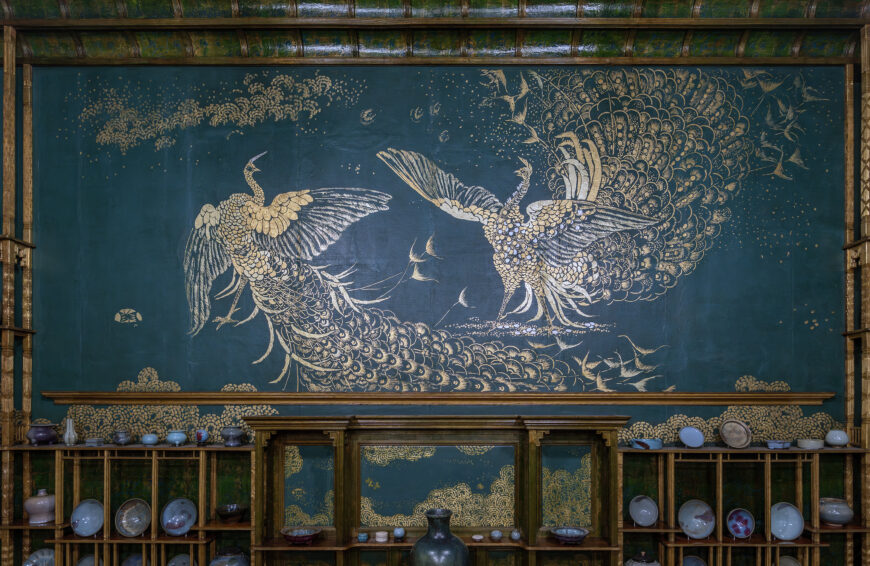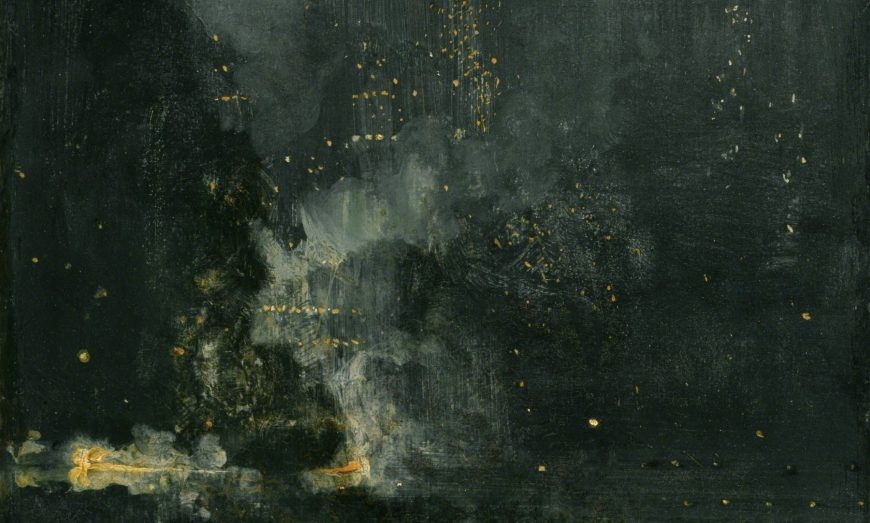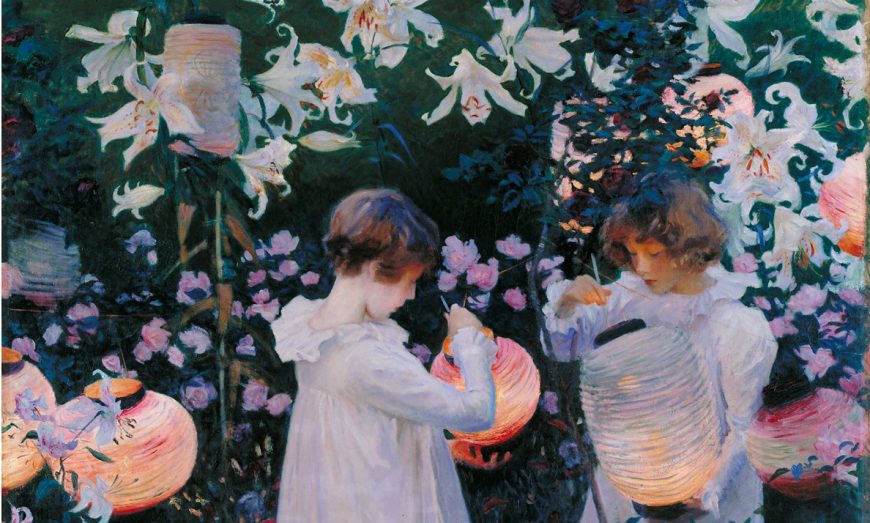Forgoing the tradition of narrative painting, Whistler aspired to create a beautiful “symphony.”
James McNeill Whistler, Symphony in White, No. 1: The White Girl, 1861–63, 1872, oil on canvas, 213 x 107.9 cm (National Gallery of Art, Washington, D.C.). Speakers: Dr. Bryan Zygmont and Dr. Beth Harris
[music]
0:00:05.2 Dr. Beth Harris: We are standing in the National Gallery in Washington, D.C. in front of a full length portrait by James McNeill Whistler. Whistler was an American artist, but spent most of his life in England, in London. This painting is called Symphony in White, No. 1: The White Girl.
0:00:22.9 Dr. Bryan Zygmont: It seems to me this is Whistler showing off, “It’s only white, but look what I can do with that.” Our sitter is Joanna Hiffernan. She’s cloaked in this white garment against a white background, and in many ways, the predominant color is white.
0:00:40.3 Dr. Harris: These beautiful white sleeves of her dress, the puff around the shoulder, the pleats at the bodice, the pattern on the curtains behind.
0:00:49.7 Dr. Zygmont: And Whistler submitted this to the Royal Academy show. It was not accepted. He then attempted to submit it to the annual Salon in Paris. It was not accepted. And instead, it was shown at the Salon des Refusés in Paris. This hung in the same exhibition as some of the real landmarks in the history of French modernism.
0:01:14.6 Dr. Harris: The Salon des Refusés was an exhibition of works that had been refused, rejected by the art establishment. And so what was it about this painting that so challenged the norms of painting in the late 19th century?
0:01:29.3 Dr. Zygmont: Whistler’s career moves on. He begins to incorporate musical words as titles. He also has nocturnes, arrangements, and he also uses the word composition. So Whistler is using musical words to describe his paintings, and he does so with a very specific goal in mind.
0:01:49.1 Dr. Harris: When we listen to music, we don’t expect to be told a story. We expect to be moved by the sounds and the rhythms. Why should we then expect anything different from painting?
0:02:01.5 Dr. Zygmont: And our initial desire is to create a kind of narrative around this. Why is she wearing a white dress? Why’s she dropped flowers? That’s where our minds want to go. What Whistler aspired to do was to create a beautiful painting. That’s it.
0:02:19.0 Dr. Harris: Behind us, is a painting by John Singer Sargent, another American artist also spending time in England. And in that painting, we read her personality in her face, in her pose. In comparison, Whistler presents us with a face that seems rather blank.
0:02:38.0 Dr. Zygmont: She looks off to the side. She’s not engaging the viewer. In the Sargent painting, there’s no doubt that this was the portrait of a wealthy socialite. Instead with Whistler’s painting, it is Whistler’s model.
0:02:52.3 Dr. Beth Harris: And Whistler is saying, “Art should be a special realm reserved only for beauty.”
0:03:00.4 Dr. Zygmont: It’s providing art this kind of elevated status. It’s not required to provide us with a moral message. It’s not even required to provide us with a subject. It can exist only as a beautiful work, one that brings one a kind of sensual joy just by looking and experiencing it.
0:03:18.7 Dr. Harris: And that idea of beauty was understood as a kind of remedy for the ugliness of modern industrial life. I think one of the things that would’ve also proved challenging to viewers in the 1860s is the looseness of the handling of the paint, especially on the bottom, where we really can’t tell where the floor ends and the wall begins, or the curtain begins. And the rug itself is painted very loosely, and we’re very aware that we’re looking at paint. And he hasn’t worked hard to convince us that this is an illusion, that this is a rug.
0:03:54.7 Dr. Zygmont: This might have been a challenging painting for contemporaries to look at, because in some ways, Whistler is breaking some of the rules that had been in place in the Western art world for centuries. There’s no real sense of recession of space or perspective. The ground seems to be tilted. Whistler is rejecting this Western idea that one of the obligations of the artist is to create a realistic three-dimensional space on a flat canvas.
0:04:22.3 Dr. Harris: Like so many artists of this period, Whistler is inspired by the art of Japan. Japanese prints were introduced into Europe at this time and had an enormous impact. And we can see that especially in the flattening of the space, the way that that floor seems to tilt upward and reads as a flat decorative pattern, instead of as a floor that recedes into space.
0:04:46.4 Dr. Zygmont: This is very much a part of that Japanese aesthetic that will become increasingly more common in Western art. The introduction of ukiyo-e prints from Japan created a different paradigm of art, and Whistler is getting started with that here, with this image from 1862. But in the years that follow, he becomes increasingly more fascinated by Japanese aesthetics. We begin to see the introduction of Japanese accessories in a number of his portraits during this time, and it, in many ways has its beginnings here.
[music]
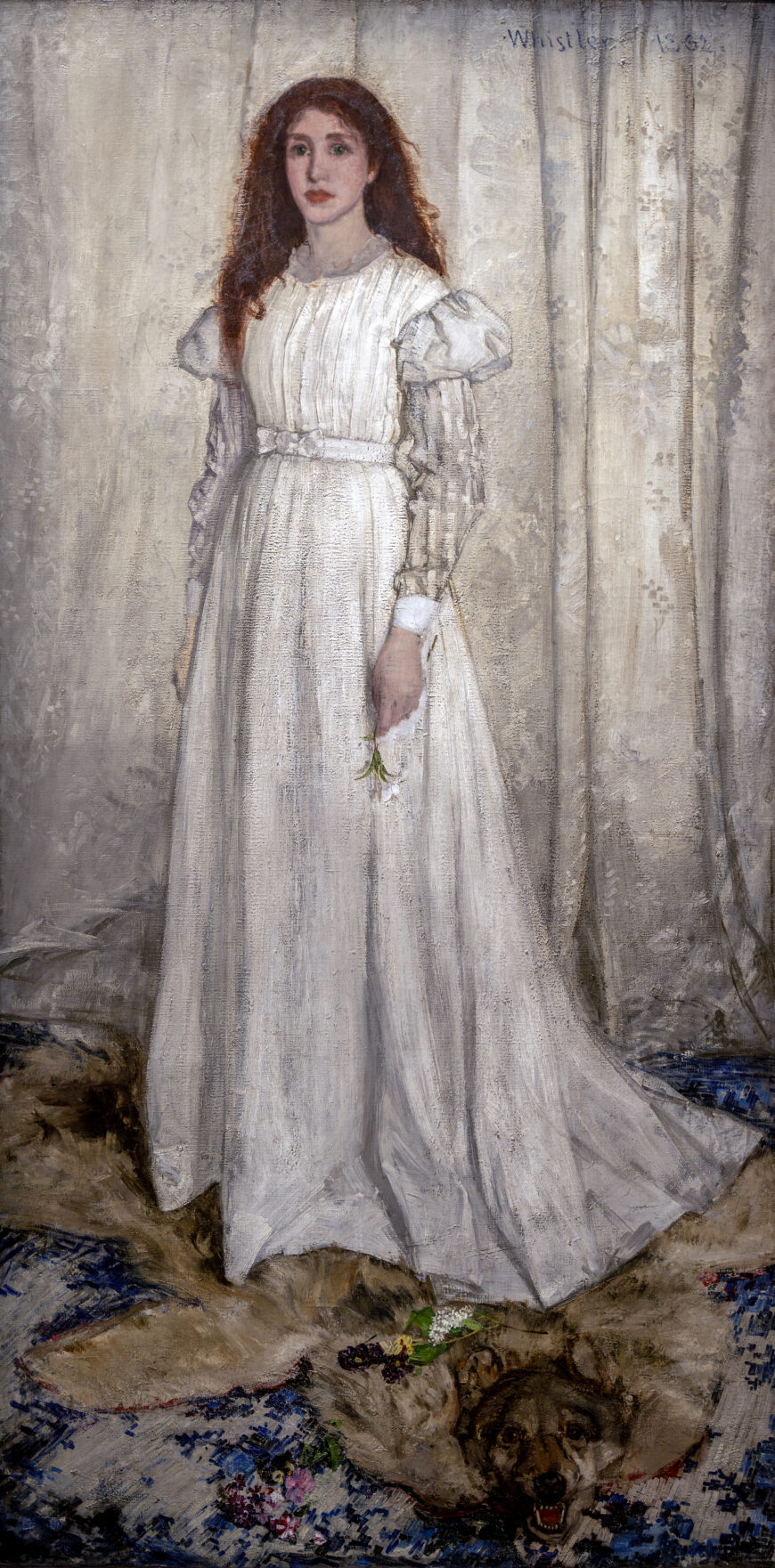
James Abbott McNeill Whistler, Symphony in White, No. 1: The White Girl, 1862, oil on canvas, 213 x 107.9 cm (National Gallery of Art, Washington, D.C.; photo: Steven Zucker, CC BY-NC-SA 2.0)
Radical portraiture
The woman in white stands facing us, her long hair loose, framing her face. Her expression is blank, her surroundings indistinct; posed before some sort of pallid curtain, she appears almost as an immobile prop on a stage.
Symphony in White, No. 1: The White Girl epitomizes James Abbott McNeill Whistler’s departure from the established norms of the era, and was perhaps his most reviled work. When he submitted it to the 1863 Paris Salon, the jury rejected the painting and the artist instead showed The White Girl at Napoleon III’s exhibition of snubbed artwork, the Salon des Refusés. Though it certainly defied many time-honored artistic conventions and earned much derision from critics, The White Girl does show some echoes of older standards. After all, its creator had studied under Marc-Charles Gabriel Gleyre in Paris, learning to paint in the academic manner—thus it is unsurprising that in the representation of his mistress, Joanna Hiffernan, Whistler opts for the customary full-scale society portrait format and reproduces her features in a seemingly realistic and honest fashion.
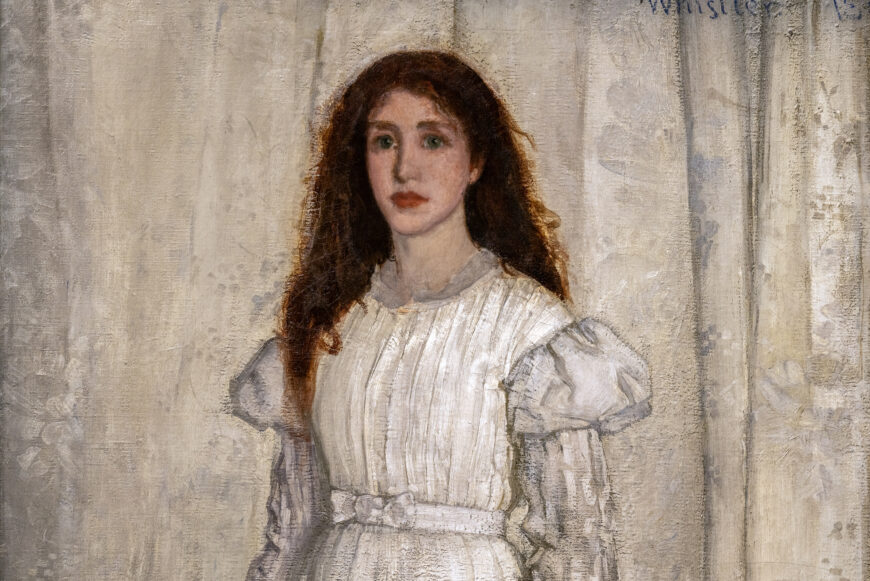
Joanna Hiffernan in white dress (detail), James Abbott McNeill Whistler, Symphony in White, No. 1: The White Girl, 1862, oil on canvas, 213 x 107.9 cm (National Gallery of Art, Washington, D.C.; photo: Steven Zucker, CC BY-NC-SA 2.0)
The ways in which Whistler follows his own rules, however, far outnumber the few examples of accord, and they include the painting’s flattened and abstracted forms, distorted perspective, limited color palette, and penchant for decorative patterning. Though an intimate portrait, The White Girl is contrived and reveals no overarching mood or the personality of its sitter. While many of Whistler’s stylistic innovations are unique to the artist, he associated himself with other artists—such as Édouard Manet and Gustave Courbet, who also defied the traditions of academicism. The influence of Théophile Gautier is also apparent; in the 1830s, Gautier stated that art need not contain any moral message or describe any narrative, as art making is an end in and of itself—Whistler accepted this credo, “art for art’s sake,” wholeheartedly. In this light, The White Girl is less a faithful portrait painting and more an experimentation in color, pattern, and texture.
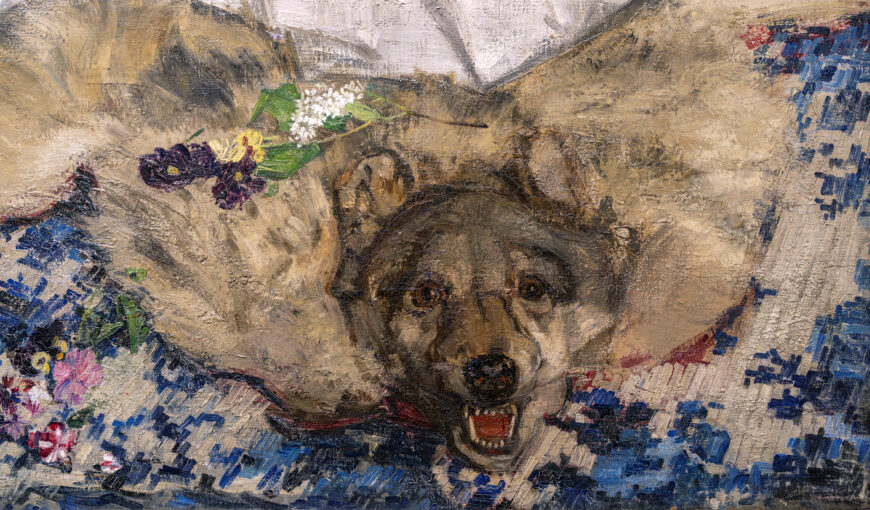
Edge of dress and flowers placed on a flat animal skin rug (detail), James Abbott McNeill Whistler, Symphony in White, No. 1: The White Girl, 1862, oil on canvas, 213 x 107.9 cm (National Gallery of Art, Washington, D.C.; photo: Steven Zucker, CC BY-NC-SA 2.0)
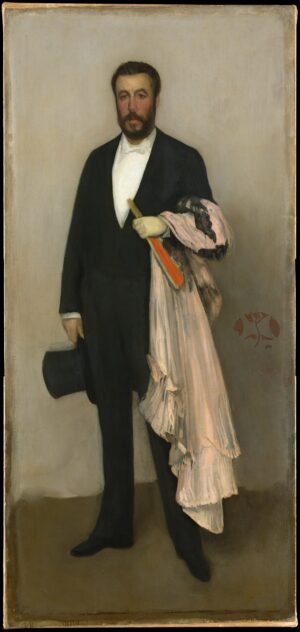
James Abbott McNeill Whistler, Arrangement in Flesh Color and Black: Portrait of Théodore Duret, 1883, oil on canvas, 193.4 x 90.8 cm (The Metropolitan Museum of Art, New York)
Whistler produced many portraits of similar format in the next decades, and continued to fine-tune his style and technique. In paintings such as Harmony in Grey and Green: Miss Cicely Alexander and Arrangement in Flesh Color and Black: Portrait of Théodore Duret, the artist exercised his need to balance the realist components of a picture with its more abstract needs, cherry-picking elements from the real world and reorganizing them in controlled, harmonious ways. Often these images feature a subdued palette, a lack of depth, unresolved backdrops, and irrational props that serve only as accents. His figures typically stand upon an unthinkably flat floor, appearing almost to hover like specters. As for Whistler’s signature, it evolved to take the form of a butterfly, applied to the surface in the manner of a mere decorative element.
Despite the controversy stirred when he entered the scene, Whistler won many wealthy and prestigious patrons over his career, and his portraits stand as testaments to growing interest in the radical new avant-garde approach to painting.


